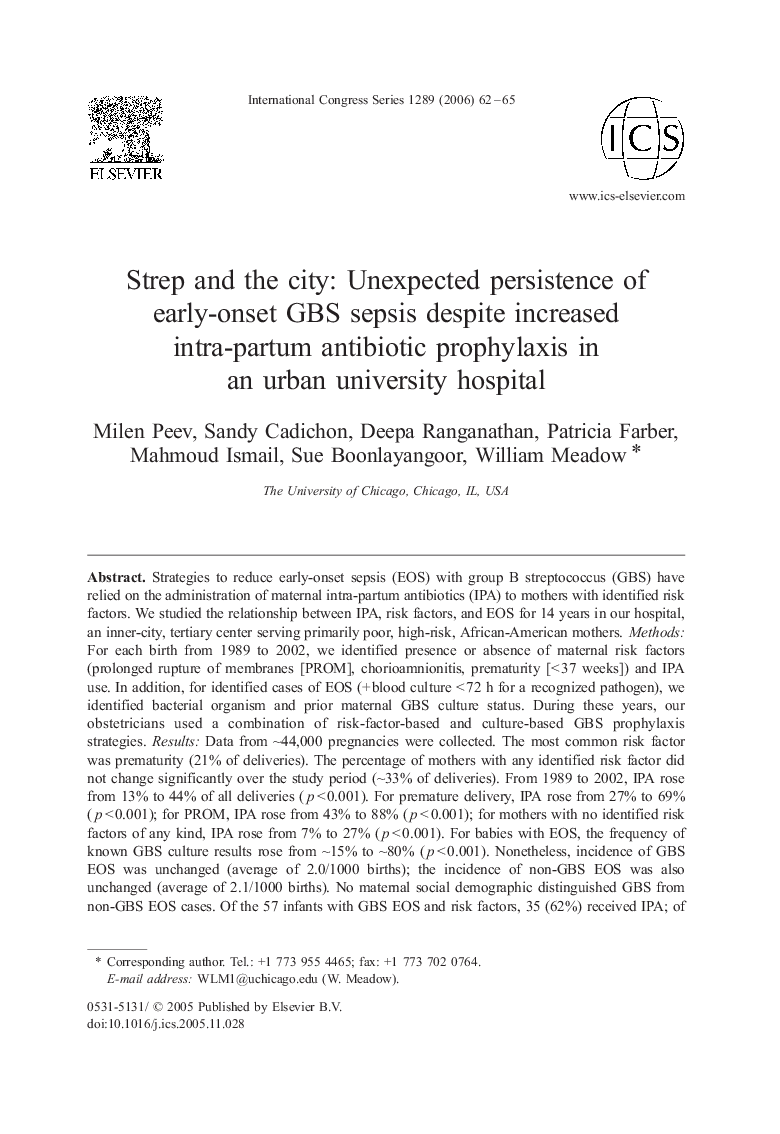| کد مقاله | کد نشریه | سال انتشار | مقاله انگلیسی | نسخه تمام متن |
|---|---|---|---|---|
| 2577407 | 1561368 | 2006 | 4 صفحه PDF | دانلود رایگان |

Strategies to reduce early-onset sepsis (EOS) with group B streptococcus (GBS) have relied on the administration of maternal intra-partum antibiotics (IPA) to mothers with identified risk factors. We studied the relationship between IPA, risk factors, and EOS for 14 years in our hospital, an inner-city, tertiary center serving primarily poor, high-risk, African-American mothers.MethodsFor each birth from 1989 to 2002, we identified presence or absence of maternal risk factors (prolonged rupture of membranes [PROM], chorioamnionitis, prematurity [< 37 weeks]) and IPA use. In addition, for identified cases of EOS (+ blood culture < 72 h for a recognized pathogen), we identified bacterial organism and prior maternal GBS culture status. During these years, our obstetricians used a combination of risk-factor-based and culture-based GBS prophylaxis strategies.ResultsData from ∼44,000 pregnancies were collected. The most common risk factor was prematurity (21% of deliveries). The percentage of mothers with any identified risk factor did not change significantly over the study period (∼33% of deliveries). From 1989 to 2002, IPA rose from 13% to 44% of all deliveries (p < 0.001). For premature delivery, IPA rose from 27% to 69% (p < 0.001); for PROM, IPA rose from 43% to 88% (p < 0.001); for mothers with no identified risk factors of any kind, IPA rose from 7% to 27% (p < 0.001). For babies with EOS, the frequency of known GBS culture results rose from ∼15% to ∼80% (p < 0.001). Nonetheless, incidence of GBS EOS was unchanged (average of 2.0/1000 births); the incidence of non-GBS EOS was also unchanged (average of 2.1/1000 births). No maternal social demographic distinguished GBS from non-GBS EOS cases. Of the 57 infants with GBS EOS and risk factors, 35 (62%) received IPA; of the 85 infants with non-GBS EOS and risk factors, 62 (73%) received IPA (p < 0.05).Conclusions1) IPA tripled between 1989 and 2002. 2) Yet EOS was unaffected—both GBS and non-GBS EOS persisted at ∼2/1000 live births. 3) We suggest that vaccination will eventually be needed to reduce GBS EOS in our institution. We have no good idea how to reduce non-GBS EOS cases.
Journal: International Congress Series - Volume 1289, April 2006, Pages 62–65